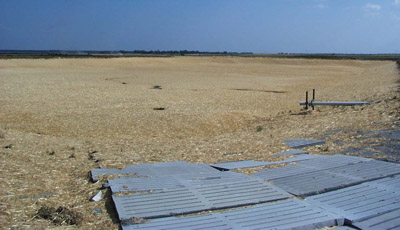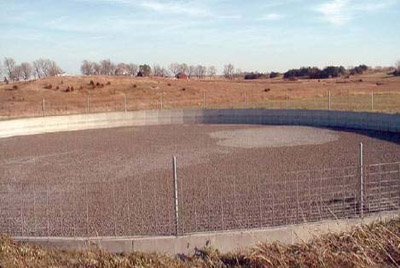Reprinted, with permission, from the proceedings of: Mitigating Air Emissions From Animal Feeding Operations Conference.
This Technology is Applicable To:
Species: Swine, Poultry
Use Area: Treatment System
Technology Category: Amendment (biological)
Air Mitigated Pollutants: Odors, Skatole
System Summary
It has been demonstrated that bioaugmentation of bioreactor with enrichment cultures and with a pure culture of Rhodococcus sp. isolated from swine lagoon is a viable alternative in reducing skatole, a main malodorous compound in swine effluent. We found that bioreactor amended with pure culture can degrade skatole as well as the enriched mixed culture after certain lag period. Pure culture bioreactor required longer lag time than the mixed culture. We also utilized these microorganisms in a liquid scrubber and found them to be quite effective in degrading skatole (data not shown). Thus, bioaugmentation of treatment systems with indigenous populations may increase the efficiency of treatment systems and provide a simple, cost-effective bioremediation potential in reducing malodors emission at livestock facilities.
Applicability and Mitigating Mechanism
- Bioaugmentation is suitable for most treatment systems that can provide sufficient environmental conditions for growth
- Target specific (pollutant)
- Total mineralization of pollutant possible
- Sustainable technology
Limitations
- Requires optimum conditions for growth
- Neutral pH and ample amount of oxygen
- Need Sufficient amount of essential nutrients
- May not work in a competitive exclusion environment and broader application range
Cost
The cost of bioaugmentation of a treatment system is dependent upon the type of the treatment systems. These microorganisms can be easily isolated and cultivated from contaminated sites. The extent of the cost would fall mostly on the purchase of nutrients for growth. In most cases, the required nutrients for growth could be obtained from the target pollutants themselves (e.g., emissions from swine or poultry wastes).
Authors
Nanh Lovanh, John Loughrin, Karamat Sistani; USDA-ARS, AWMRU, Bowling Green, KY 42104
Point of Contact:
Nanh Lobanh, nlovanh@ars.usda.gov
The information provided here was developed for the conference Mitigating Air Emissions From Animal Feeding Operations Conference held in May 2008. To obtain updates, readers are encouraged to contact the author.





